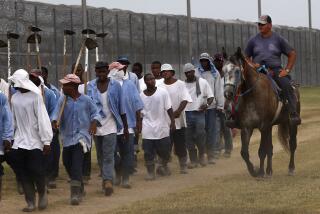Trouble at El Centro
U.S. immigration officials play down the significance of a recent hunger strike by inmates at their El Centro detention facility. But the incident, and the way it was dealt with, are reminders of how poorly this country has treated many would-be refugees from Central America.
Inmates said that the hunger strike was a protest against overcrowded conditions at the detention camp. This is disputed by officials of the U.S. Immigration and Naturalization Service, who contend that the strike was orchestrated by political activists outside the facility. There is also disagreement as to how many inmates were involved and whether the physical force used to suppress the protest was justified.
Regardless of what happened, however, certain facts are indisputable. The El Centro facility, a spartan cluster of buildings in the Imperial Valley desert, has been overcrowded for some time. Originally designed to hold 340 persons, it has housed 400 to 500 men for several months now. Also, the length of stay for many inmates there is longer than ever before. Suspected illegal immigrants held there have requested formal deportation hearings rather than leaving the United States voluntarily. As more would-be refugees from Central America request such hearings, waits at El Centro have gone from days to months.
Additionally, officials at the detention camp had denied some attorneys access to inmates who were their clients just before the strike began. Once the strike had started, officials first isolated the handful of inmates who were suspected of being strike leaders, then began transferring them to other immigration service detention facilities without informing their attorneys or relatives that they had been moved.
Immigration service spokesmen say that the agency’s response to the hunger strike was so tough because the strike constituted an “emergency situation” at the detention center. But there is little evidence that the standoff had reached a dangerous level when immigration officers moved against the strikers. Even if it had, that does not justify spiriting away people in custody without giving them access to attorneys or notifying their families.
But it would be unfair to lay the blame for what happened at El Centro solely on the immigration service or on activist attorneys who may have encouraged their clients to be defiant. The real problem is a stubborn Reagan Administration policy that contributes to the overcrowding there and at other immigration facilities.
The Administration refuses to allow illegal immigrants from El Salvador to remain in this country until the bloody civil war in their homeland is over. The immigration service could do this through an administrative procedure known as extended voluntary departure--a special status that is routinely granted to refugees from nations in political turmoil, like Poland. Even El Salvador’s President Jose Napoleon Duarte has suggested that this would be the best way for the United States to handle the continuing flight of refugees from his country. Until detained Salvadorans are granted this special immigration status, conditions at detention centers like El Centro will worsen, and so will the tensions that create incidents like the hunger strike.
More to Read
Sign up for Essential California
The most important California stories and recommendations in your inbox every morning.
You may occasionally receive promotional content from the Los Angeles Times.










